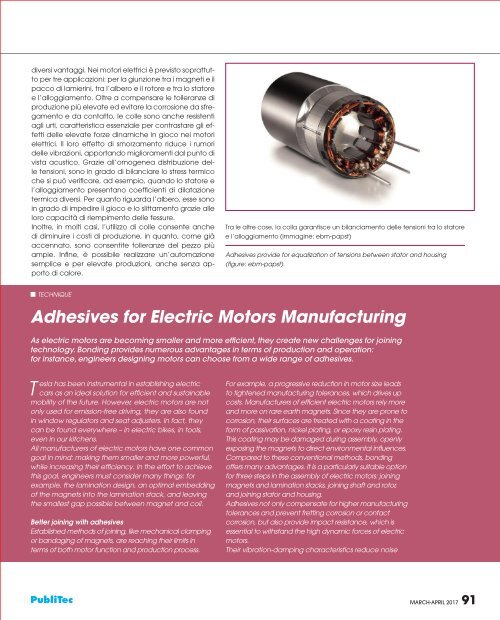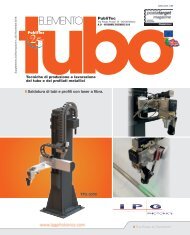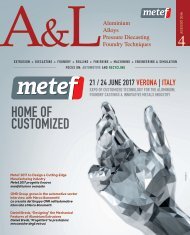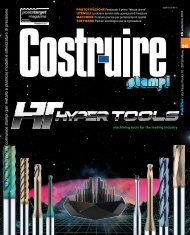ASSEMBLAGGIO_n119_MARZO_APRILE_2017
Create successful ePaper yourself
Turn your PDF publications into a flip-book with our unique Google optimized e-Paper software.
diversi vantaggi. Nei motori elettrici è previsto soprattutto<br />
per tre applicazioni: per la giunzione tra i magneti e il<br />
pacco di lamierini, tra l’albero e il rotore e tra lo statore<br />
e l’alloggiamento. Oltre a compensare le tolleranze di<br />
produzione più elevate ed evitare la corrosione da sfregamento<br />
e da contatto, le colle sono anche resistenti<br />
agli urti, caratteristica essenziale per contrastare gli effetti<br />
delle elevate forze dinamiche in gioco nei motori<br />
elettrici. Il loro effetto di smorzamento riduce i rumori<br />
delle vibrazioni, apportando miglioramenti dal punto di<br />
vista acustico. Grazie all’omogenea distribuzione delle<br />
tensioni, sono in grado di bilanciare lo stress termico<br />
che si può verificare, ad esempio, quando lo statore e<br />
l’alloggiamento presentano coefficienti di dilatazione<br />
termica diversi. Per quanto riguarda l’albero, esse sono<br />
in grado di impedire il gioco e lo slittamento grazie alle<br />
loro capacità di riempimento delle fessure.<br />
Inoltre, in molti casi, l’utilizzo di colle consente anche<br />
di diminuire i costi di produzione, in quanto, come già<br />
accennato, sono consentite tolleranze del pezzo più<br />
ampie. Infine, è possibile realizzare un’automazione<br />
semplice e per elevate produzioni, anche senza apporto<br />
di calore.<br />
Tra le altre cose, la colla garantisce un bilanciamento delle tensioni tra lo statore<br />
e l’alloggiamento (immagine: ebm-papst)<br />
Adhesives provide for equalization of tensions between stator and housing<br />
(figure: ebm-papst).<br />
n TECHNIQUE<br />
Adhesives for Electric Motors Manufacturing<br />
As electric motors are becoming smaller and more efficient, they create new challenges for joining<br />
technology. Bonding provides numerous advantages in terms of production and operation:<br />
for instance, engineers designing motors can choose from a wide range of adhesives.<br />
T<br />
esla has been instrumental in establishing electric<br />
cars as an ideal solution for efficient and sustainable<br />
mobility of the future. However, electric motors are not<br />
only used for emission-free driving, they are also found<br />
in window regulators and seat adjusters. In fact, they<br />
can be found everywhere – in electric bikes, in tools,<br />
even in our kitchens.<br />
All manufacturers of electric motors have one common<br />
goal in mind: making them smaller and more powerful,<br />
while increasing their efficiency. In the effort to achieve<br />
this goal, engineers must consider many things: for<br />
example, the lamination design, an optimal embedding<br />
of the magnets into the lamination stack, and leaving<br />
the smallest gap possible between magnet and coil.<br />
Better joining with adhesives<br />
Established methods of joining, like mechanical clamping<br />
or bandaging of magnets, are reaching their limits in<br />
terms of both motor function and production process.<br />
For example, a progressive reduction in motor size leads<br />
to tightened manufacturing tolerances, which drives up<br />
costs. Manufacturers of efficient electric motors rely more<br />
and more on rare earth magnets. Since they are prone to<br />
corrosion, their surfaces are treated with a coating in the<br />
form of passivation, nickel plating, or epoxy resin plating.<br />
This coating may be damaged during assembly, openly<br />
exposing the magnets to direct environmental influences.<br />
Compared to these conventional methods, bonding<br />
offers many advantages. It is a particularly suitable option<br />
for three steps in the assembly of electric motors: joining<br />
magnets and lamination stacks, joining shaft and rotor,<br />
and joining stator and housing.<br />
Adhesives not only compensate for higher manufacturing<br />
tolerances and prevent fretting corrosion or contact<br />
corrosion, but also provide impact resistance, which is<br />
essential to withstand the high dynamic forces of electric<br />
motors.<br />
Their vibration-damping characteristics reduce noise<br />
PubliTec<br />
MARCH-APRIL <strong>2017</strong> 91





